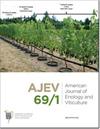两种土壤的机械修剪和土壤有机改良。对葡萄酒化学成分和感官特征的影响
IF 1.8
3区 农林科学
Q3 BIOTECHNOLOGY & APPLIED MICROBIOLOGY
引用次数: 0
摘要
关于机械修剪与土壤有机改良之间相互作用的知识仍然很少。本研究旨在检验这两种做法之间的相互作用对葡萄酒质量的影响。来自葡萄牙两个试验田的西拉葡萄经过两种不同的修剪系统(机械修剪;手刺修剪)和五种不同的有机改良处理(对照、生物炭、城市固体废物堆肥、牛粪和污水污泥),收获并酿造四年。机械修剪显著降低了葡萄酒的酒精浓度、pH值和花青素总量。机械修剪和有机改良剂,有趋势地降低葡萄酒的总酚和单宁能力,被称为“葡萄酒收敛潜力的评估”。品尝者发现,修剪系统在全球范围内的鉴赏力差异很小,但却很显著。污泥往往比城市固体废物堆肥和牛粪更能降低葡萄酒的全球升值,而与对照相比,生物炭对品尝者的偏好没有影响。产量和品尝者的偏好之间有很强的关系,仅在6公斤/株和8公斤/株以上,具体取决于风土。当产量提高到一定水平以上时,机械修剪对葡萄酒品质有显著影响。因此,使用这种修剪系统,必须考虑生产葡萄的命运来选择有机改良剂及其用量。据我们所知,机械修剪和土壤有机改良对葡萄酒质量的影响是一个新颖的现象。本文章由计算机程序翻译,如有差异,请以英文原文为准。
Mechanical Pruning and Soil Organic Amending in Two Terroirs. Effects on Wine Chemical Composition and Sensory Profile
The knowledge about the interaction between mechanical pruning and soil organic amending is still scarce. This study aimed to examine the effects of the interaction between these two practices on wine quality. Syrah grapes from two trial fields in Portugal subjected to two different pruning systems (mechanical pruning; hand spur pruning) and five different organic amendment treatments (control, biochar, municipal solid waste compost, cattle manure, and sewage sludge) were harvested and vinified for four years. Mechanical pruning significantly reduced wine alcoholic strength, pH, and total anthocyanins. Mechanical pruning and organic amendments, tendentially reduced wine total phenols and tannin power, known as an “estimation of the astringency potential of the wines”. Tasters found low but significant differences in global appreciation with the pruning system. Sludge tended to reduce wine global appreciation more than municipal solid waste compost and cattle manure, while biochar had no effect on tasters’ preference when compared to the control. There was strong relation between yield and tasters’ preference only above 6 kg/vine and 8 kg/vine depending on the terroir. Mechanical pruning tendentially has significant effects on wine quality when yield raises above a certain level. Thus, with this pruning system, the choice of the organic amendment and its amount must be done considering the destiny of the produced grapes. To the best of our knowledge, effects of the interaction of mechanical pruning with soil organic amending on wine quality are a novelty.
求助全文
通过发布文献求助,成功后即可免费获取论文全文。
去求助
来源期刊

American Journal of Enology and Viticulture
农林科学-生物工程与应用微生物
CiteScore
3.80
自引率
10.50%
发文量
27
审稿时长
12-24 weeks
期刊介绍:
The American Journal of Enology and Viticulture (AJEV), published quarterly, is an official journal of the American Society for Enology and Viticulture (ASEV) and is the premier journal in the English language dedicated to scientific research on winemaking and grapegrowing. AJEV publishes full-length research papers, literature reviews, research notes, and technical briefs on various aspects of enology and viticulture, including wine chemistry, sensory science, process engineering, wine quality assessments, microbiology, methods development, plant pathogenesis, diseases and pests of grape, rootstock and clonal evaluation, effect of field practices, and grape genetics and breeding. All papers are peer reviewed, and authorship of papers is not limited to members of ASEV. The science editor, along with the viticulture, enology, and associate editors, are drawn from academic and research institutions worldwide and guide the content of the Journal.
 求助内容:
求助内容: 应助结果提醒方式:
应助结果提醒方式:


